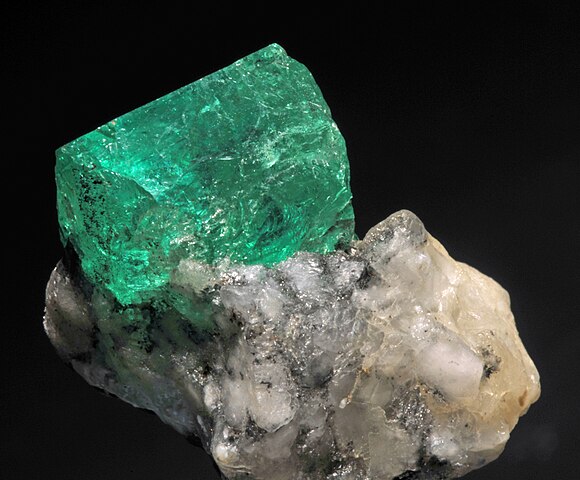Emerald
Emerald is a gemstone and a variety of the mineral beryl colored green by trace amounts of chromium or sometimes vanadium. Beryl has a hardness of 7.5–8 on the Mohs scale. Most emeralds have lots of material trapped inside during the gem's formation, so their toughness is classified as generally poor.
This member of the beryl family ranks among the traditional "big four" gems along with diamonds, rubies and sapphires.
Emerald mines
Emeralds in antiquity were mined in Ancient Egypt at locations on Mount Smaragdus since 1500 BC, and India and Austria since at least the 14th century AD. The Egyptian mines were exploited on an industrial scale by the Roman and Byzantine Empires, and later by Islamic conquerors. Mining in Egypt ceased with the discovery of the Colombian deposits. Today, only ruins remain in Egypt.
Colombia is by far the world's largest producer of emeralds, constituting 50–95% of the world production, with the number depending on the year, source and grade. Emerald production in Colombia has increased drastically in the last decade, increasing by 78% from 2000 to 2010. The three main emerald mining areas in Colombia are Muzo, Coscuez, and Chivor. Rare "trapiche" emeralds are found in Colombia, distinguished by ray-like spokes of dark impurities.
Use in ancient Egypt
The variant of emerald found in Egyptian jewelry is mainly light to medium green and translucent, but only rarely dark green and transparent. It was used rarely throughout the Late Period, but more commonly during the Roman Period. There were a total of six mines in the ancient Mons Smaragdus region. Some emerald may have been imported from India.
Emeralds were crafted into beads for necklaces and also mounted as single stones inside gold or silver settings.
The ancient Graeco-Roman names were smaragdos/smaragdus.
Folklore
Emerald is regarded as the traditional birthstone for May as well as the traditional gemstone for the astrological sign of Cancer. It is also the stone associated with the angel Hamaliel.
Traditional alchemical lore ascribes several uses and characteristics to emeralds: "The virtue of the Emerald is to counteract poison. They say that if a venomous animal should look at it, it will become blinded. The gem also acts as a preservative against epilepsy; it cures leprosy, strengthens sight and memory, checks copulation, during which act it will break, if worn at the time on the finger."
The chief deity of one of India's most famous temples, the Meenakshi Amman Temple in Madurai, is the goddess Meenakshi, whose idol is traditionally thought to be made of emerald.
The Emerald Tablet is a fundamental text in alchemy.
